Assignment 1: Layers of TCP/IP and OSI Models in IT Networking
VerifiedAdded on 2023/03/17
|6
|1480
|60
Homework Assignment
AI Summary
This assignment provides a comprehensive overview of the TCP/IP and OSI models, crucial for understanding IT networking and communication. It begins by listing and comparing the layers of both models, highlighting their correlations and functions. The assignment explores data encapsulation, explaining how data is packaged and transmitted across networks. It delves into the responsibilities of the Data Link, Network, and Transport layers, clarifying the differences between network and transport layer delivery and the need for error detection mechanisms at multiple levels. The roles of port, logical, and physical addresses are elucidated, along with services offered by the Application layer. Finally, the assignment discusses the advantages of combining layers in the TCP/IP protocol suite. The content covers key concepts such as network support layers, user support layers, and the intricacies of data transfer within network architectures.
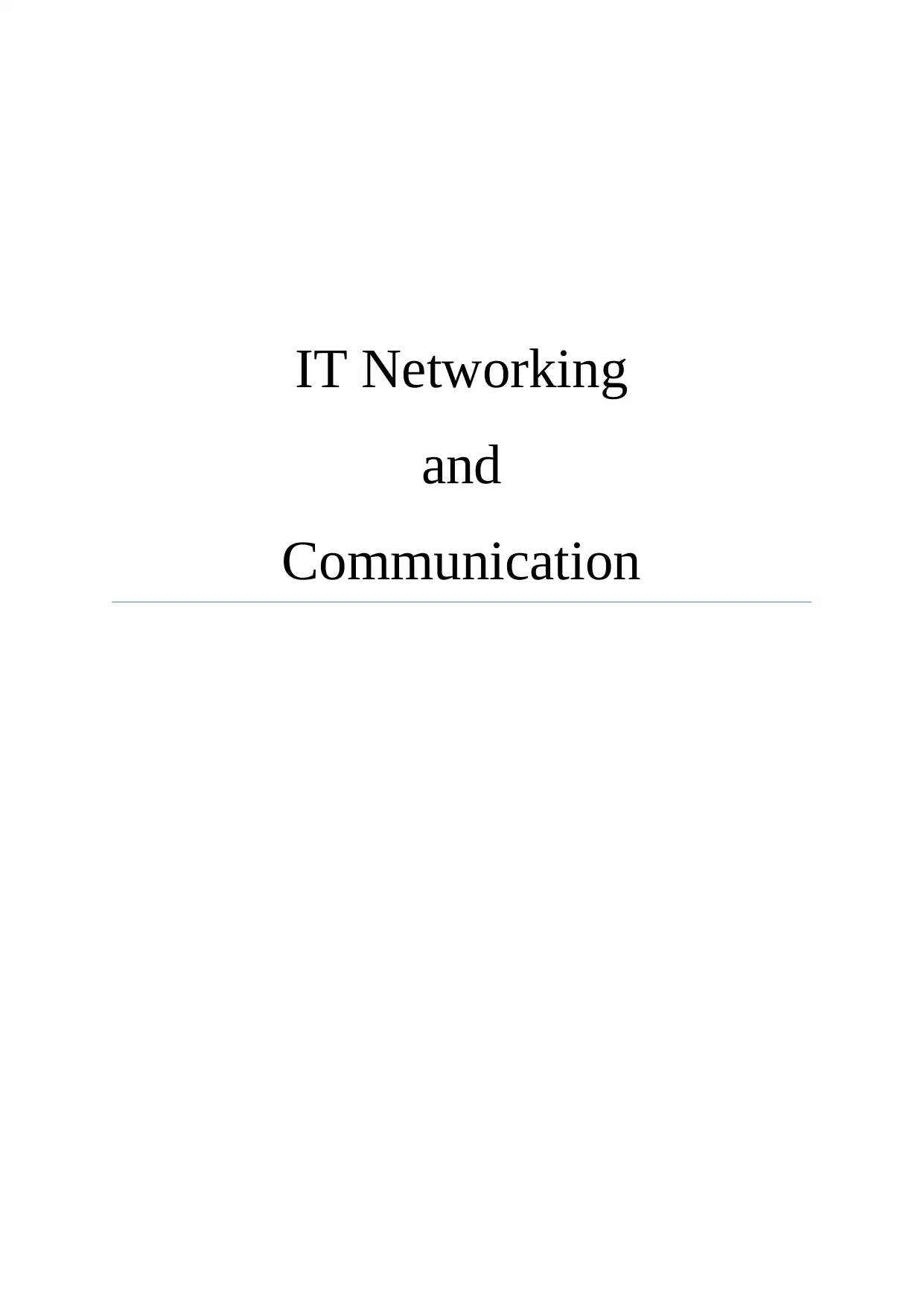
IT Networking
and
Communication
and
Communication
Paraphrase This Document
Need a fresh take? Get an instant paraphrase of this document with our AI Paraphraser

1
TCP/IP protocol suite layer and OSI model’s layer
Layers of TCP/IP layers are Network Access/Link layer, Process/Application layer, Host-to-
Host and Internet layer. At the same time, in order from bottom to top, the OSI layers are
Physical layer, Data Link Layer, Network layer, Transport layer, Session layer, presentation
layer and application layer respectively (Montreuil, Ballot and Fontane, 2012).
TCP/IP and OSI layer correlation
High degree of correlation exists between OSI layers and TCP/IP layers. Network layer of
TCP/IP model is a mixture of OSI model’s Physical and Data link layer as they have the
same function of looking out for addressing of protocols required for physical delivery of
data and also for addressing of hardware. Network layer of OSI model corresponds to internet
layer of TCP/IP. It suggests the rules that are necessary for logical delivery of data within the
network (Li, et al. 2011).
Transport layer of OSI layer corresponds to internet suite of TCP/IP layer. They are doing the
work of end-to-end communication and error-free data delivery. They protect upper-layer
applications from the complexity of data. Application, session and presentation layer of OSI
resembles to process layer in TCP/IP. They all have the role of describing details of the user-
interface and they do point-to-point communication (Edwards and Bramante, 2015).
Layers that are network support layers
Internet and Network layers are understood as network support layers in the TCP/IP protocol
suite while Host-to-Host and process layers are layers for user support.
Data encapsulation
Primary unit of information is packets. They are transported all across the network having
minimum numbers of headers and have sending and receiving host addresses as well as a
body along with the data that has to be moved. When packet goes through TCP/IP protocol
stack, each layer’s protocols either adds or removes fields from the primary headers (Alani,
2014). During this when protocol sends host add some data in the packet header, this process
is understood as data encapsulation.
TCP/IP protocol suite layer and OSI model’s layer
Layers of TCP/IP layers are Network Access/Link layer, Process/Application layer, Host-to-
Host and Internet layer. At the same time, in order from bottom to top, the OSI layers are
Physical layer, Data Link Layer, Network layer, Transport layer, Session layer, presentation
layer and application layer respectively (Montreuil, Ballot and Fontane, 2012).
TCP/IP and OSI layer correlation
High degree of correlation exists between OSI layers and TCP/IP layers. Network layer of
TCP/IP model is a mixture of OSI model’s Physical and Data link layer as they have the
same function of looking out for addressing of protocols required for physical delivery of
data and also for addressing of hardware. Network layer of OSI model corresponds to internet
layer of TCP/IP. It suggests the rules that are necessary for logical delivery of data within the
network (Li, et al. 2011).
Transport layer of OSI layer corresponds to internet suite of TCP/IP layer. They are doing the
work of end-to-end communication and error-free data delivery. They protect upper-layer
applications from the complexity of data. Application, session and presentation layer of OSI
resembles to process layer in TCP/IP. They all have the role of describing details of the user-
interface and they do point-to-point communication (Edwards and Bramante, 2015).
Layers that are network support layers
Internet and Network layers are understood as network support layers in the TCP/IP protocol
suite while Host-to-Host and process layers are layers for user support.
Data encapsulation
Primary unit of information is packets. They are transported all across the network having
minimum numbers of headers and have sending and receiving host addresses as well as a
body along with the data that has to be moved. When packet goes through TCP/IP protocol
stack, each layer’s protocols either adds or removes fields from the primary headers (Alani,
2014). During this when protocol sends host add some data in the packet header, this process
is understood as data encapsulation.
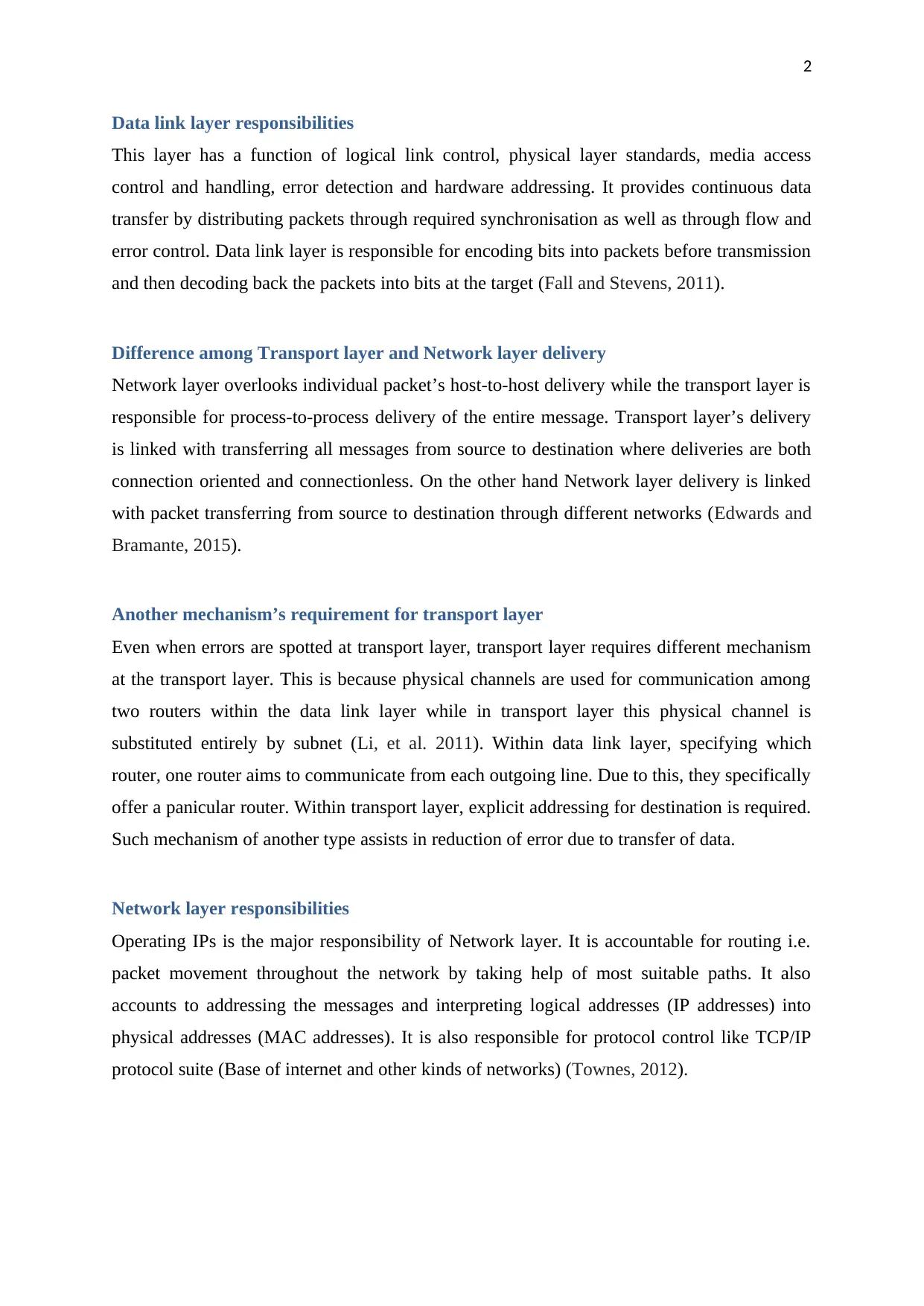
2
Data link layer responsibilities
This layer has a function of logical link control, physical layer standards, media access
control and handling, error detection and hardware addressing. It provides continuous data
transfer by distributing packets through required synchronisation as well as through flow and
error control. Data link layer is responsible for encoding bits into packets before transmission
and then decoding back the packets into bits at the target (Fall and Stevens, 2011).
Difference among Transport layer and Network layer delivery
Network layer overlooks individual packet’s host-to-host delivery while the transport layer is
responsible for process-to-process delivery of the entire message. Transport layer’s delivery
is linked with transferring all messages from source to destination where deliveries are both
connection oriented and connectionless. On the other hand Network layer delivery is linked
with packet transferring from source to destination through different networks (Edwards and
Bramante, 2015).
Another mechanism’s requirement for transport layer
Even when errors are spotted at transport layer, transport layer requires different mechanism
at the transport layer. This is because physical channels are used for communication among
two routers within the data link layer while in transport layer this physical channel is
substituted entirely by subnet (Li, et al. 2011). Within data link layer, specifying which
router, one router aims to communicate from each outgoing line. Due to this, they specifically
offer a panicular router. Within transport layer, explicit addressing for destination is required.
Such mechanism of another type assists in reduction of error due to transfer of data.
Network layer responsibilities
Operating IPs is the major responsibility of Network layer. It is accountable for routing i.e.
packet movement throughout the network by taking help of most suitable paths. It also
accounts to addressing the messages and interpreting logical addresses (IP addresses) into
physical addresses (MAC addresses). It is also responsible for protocol control like TCP/IP
protocol suite (Base of internet and other kinds of networks) (Townes, 2012).
Data link layer responsibilities
This layer has a function of logical link control, physical layer standards, media access
control and handling, error detection and hardware addressing. It provides continuous data
transfer by distributing packets through required synchronisation as well as through flow and
error control. Data link layer is responsible for encoding bits into packets before transmission
and then decoding back the packets into bits at the target (Fall and Stevens, 2011).
Difference among Transport layer and Network layer delivery
Network layer overlooks individual packet’s host-to-host delivery while the transport layer is
responsible for process-to-process delivery of the entire message. Transport layer’s delivery
is linked with transferring all messages from source to destination where deliveries are both
connection oriented and connectionless. On the other hand Network layer delivery is linked
with packet transferring from source to destination through different networks (Edwards and
Bramante, 2015).
Another mechanism’s requirement for transport layer
Even when errors are spotted at transport layer, transport layer requires different mechanism
at the transport layer. This is because physical channels are used for communication among
two routers within the data link layer while in transport layer this physical channel is
substituted entirely by subnet (Li, et al. 2011). Within data link layer, specifying which
router, one router aims to communicate from each outgoing line. Due to this, they specifically
offer a panicular router. Within transport layer, explicit addressing for destination is required.
Such mechanism of another type assists in reduction of error due to transfer of data.
Network layer responsibilities
Operating IPs is the major responsibility of Network layer. It is accountable for routing i.e.
packet movement throughout the network by taking help of most suitable paths. It also
accounts to addressing the messages and interpreting logical addresses (IP addresses) into
physical addresses (MAC addresses). It is also responsible for protocol control like TCP/IP
protocol suite (Base of internet and other kinds of networks) (Townes, 2012).
⊘ This is a preview!⊘
Do you want full access?
Subscribe today to unlock all pages.

Trusted by 1+ million students worldwide
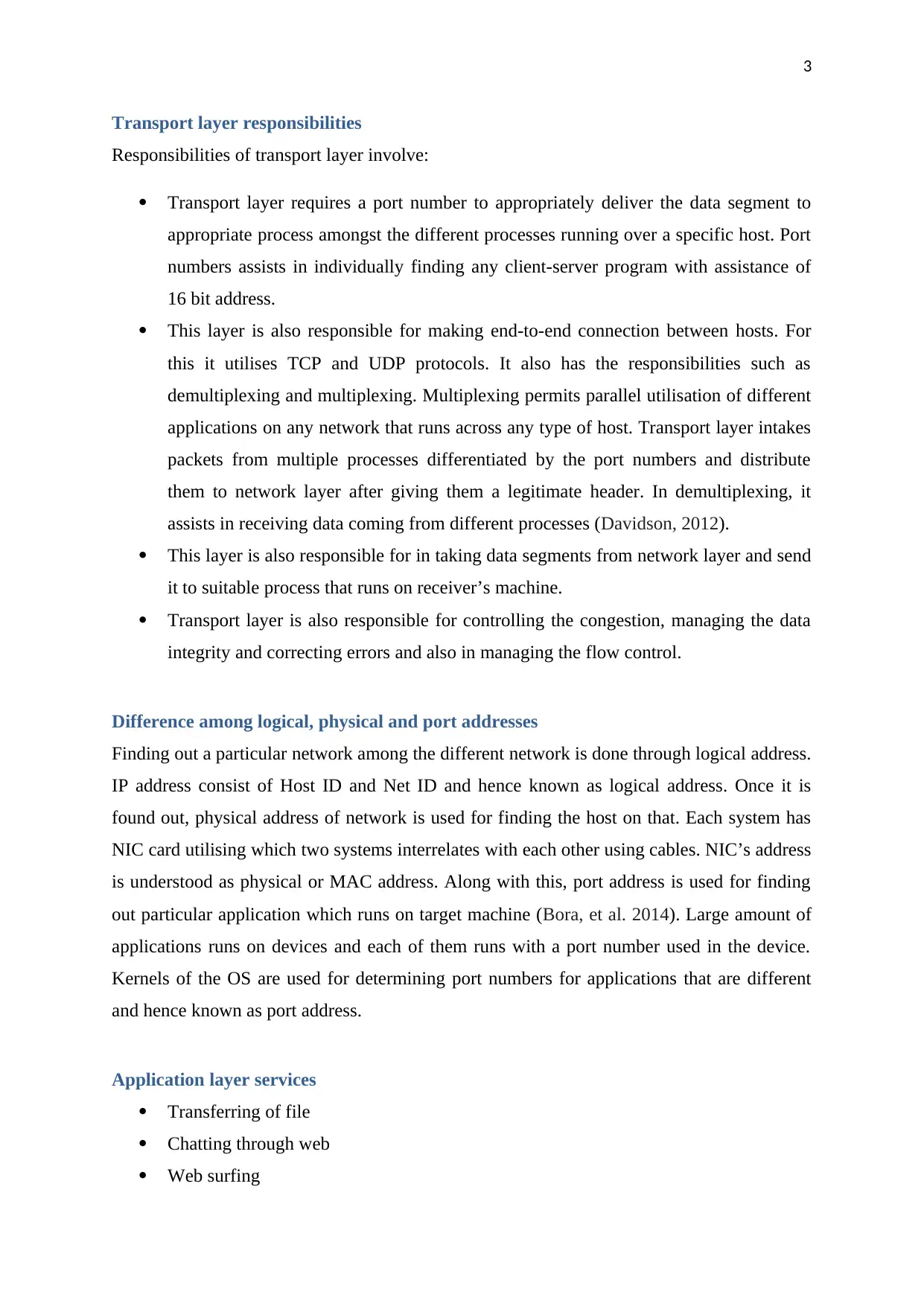
3
Transport layer responsibilities
Responsibilities of transport layer involve:
Transport layer requires a port number to appropriately deliver the data segment to
appropriate process amongst the different processes running over a specific host. Port
numbers assists in individually finding any client-server program with assistance of
16 bit address.
This layer is also responsible for making end-to-end connection between hosts. For
this it utilises TCP and UDP protocols. It also has the responsibilities such as
demultiplexing and multiplexing. Multiplexing permits parallel utilisation of different
applications on any network that runs across any type of host. Transport layer intakes
packets from multiple processes differentiated by the port numbers and distribute
them to network layer after giving them a legitimate header. In demultiplexing, it
assists in receiving data coming from different processes (Davidson, 2012).
This layer is also responsible for in taking data segments from network layer and send
it to suitable process that runs on receiver’s machine.
Transport layer is also responsible for controlling the congestion, managing the data
integrity and correcting errors and also in managing the flow control.
Difference among logical, physical and port addresses
Finding out a particular network among the different network is done through logical address.
IP address consist of Host ID and Net ID and hence known as logical address. Once it is
found out, physical address of network is used for finding the host on that. Each system has
NIC card utilising which two systems interrelates with each other using cables. NIC’s address
is understood as physical or MAC address. Along with this, port address is used for finding
out particular application which runs on target machine (Bora, et al. 2014). Large amount of
applications runs on devices and each of them runs with a port number used in the device.
Kernels of the OS are used for determining port numbers for applications that are different
and hence known as port address.
Application layer services
Transferring of file
Chatting through web
Web surfing
Transport layer responsibilities
Responsibilities of transport layer involve:
Transport layer requires a port number to appropriately deliver the data segment to
appropriate process amongst the different processes running over a specific host. Port
numbers assists in individually finding any client-server program with assistance of
16 bit address.
This layer is also responsible for making end-to-end connection between hosts. For
this it utilises TCP and UDP protocols. It also has the responsibilities such as
demultiplexing and multiplexing. Multiplexing permits parallel utilisation of different
applications on any network that runs across any type of host. Transport layer intakes
packets from multiple processes differentiated by the port numbers and distribute
them to network layer after giving them a legitimate header. In demultiplexing, it
assists in receiving data coming from different processes (Davidson, 2012).
This layer is also responsible for in taking data segments from network layer and send
it to suitable process that runs on receiver’s machine.
Transport layer is also responsible for controlling the congestion, managing the data
integrity and correcting errors and also in managing the flow control.
Difference among logical, physical and port addresses
Finding out a particular network among the different network is done through logical address.
IP address consist of Host ID and Net ID and hence known as logical address. Once it is
found out, physical address of network is used for finding the host on that. Each system has
NIC card utilising which two systems interrelates with each other using cables. NIC’s address
is understood as physical or MAC address. Along with this, port address is used for finding
out particular application which runs on target machine (Bora, et al. 2014). Large amount of
applications runs on devices and each of them runs with a port number used in the device.
Kernels of the OS are used for determining port numbers for applications that are different
and hence known as port address.
Application layer services
Transferring of file
Chatting through web
Web surfing
Paraphrase This Document
Need a fresh take? Get an instant paraphrase of this document with our AI Paraphraser
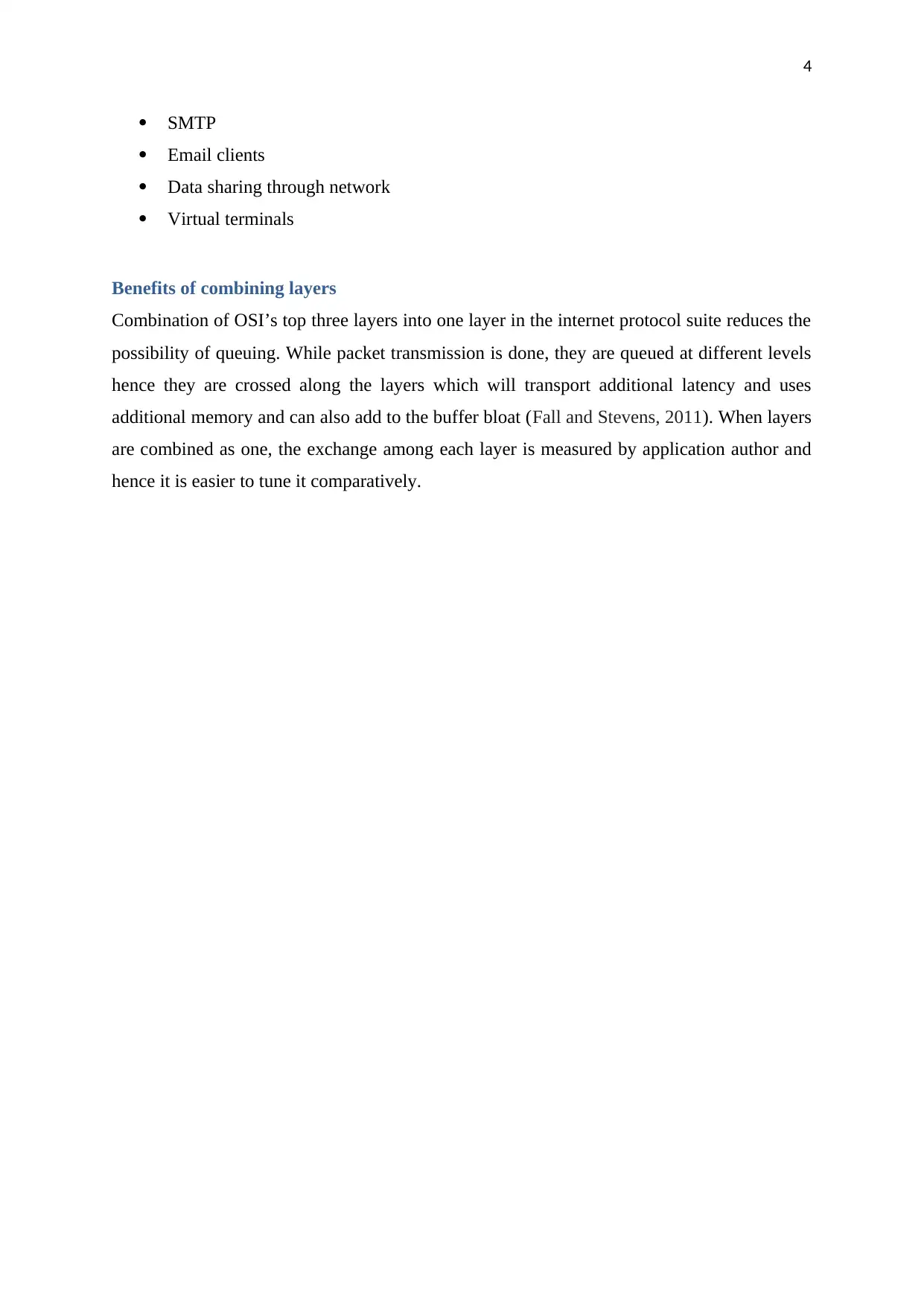
4
SMTP
Email clients
Data sharing through network
Virtual terminals
Benefits of combining layers
Combination of OSI’s top three layers into one layer in the internet protocol suite reduces the
possibility of queuing. While packet transmission is done, they are queued at different levels
hence they are crossed along the layers which will transport additional latency and uses
additional memory and can also add to the buffer bloat (Fall and Stevens, 2011). When layers
are combined as one, the exchange among each layer is measured by application author and
hence it is easier to tune it comparatively.
SMTP
Email clients
Data sharing through network
Virtual terminals
Benefits of combining layers
Combination of OSI’s top three layers into one layer in the internet protocol suite reduces the
possibility of queuing. While packet transmission is done, they are queued at different levels
hence they are crossed along the layers which will transport additional latency and uses
additional memory and can also add to the buffer bloat (Fall and Stevens, 2011). When layers
are combined as one, the exchange among each layer is measured by application author and
hence it is easier to tune it comparatively.
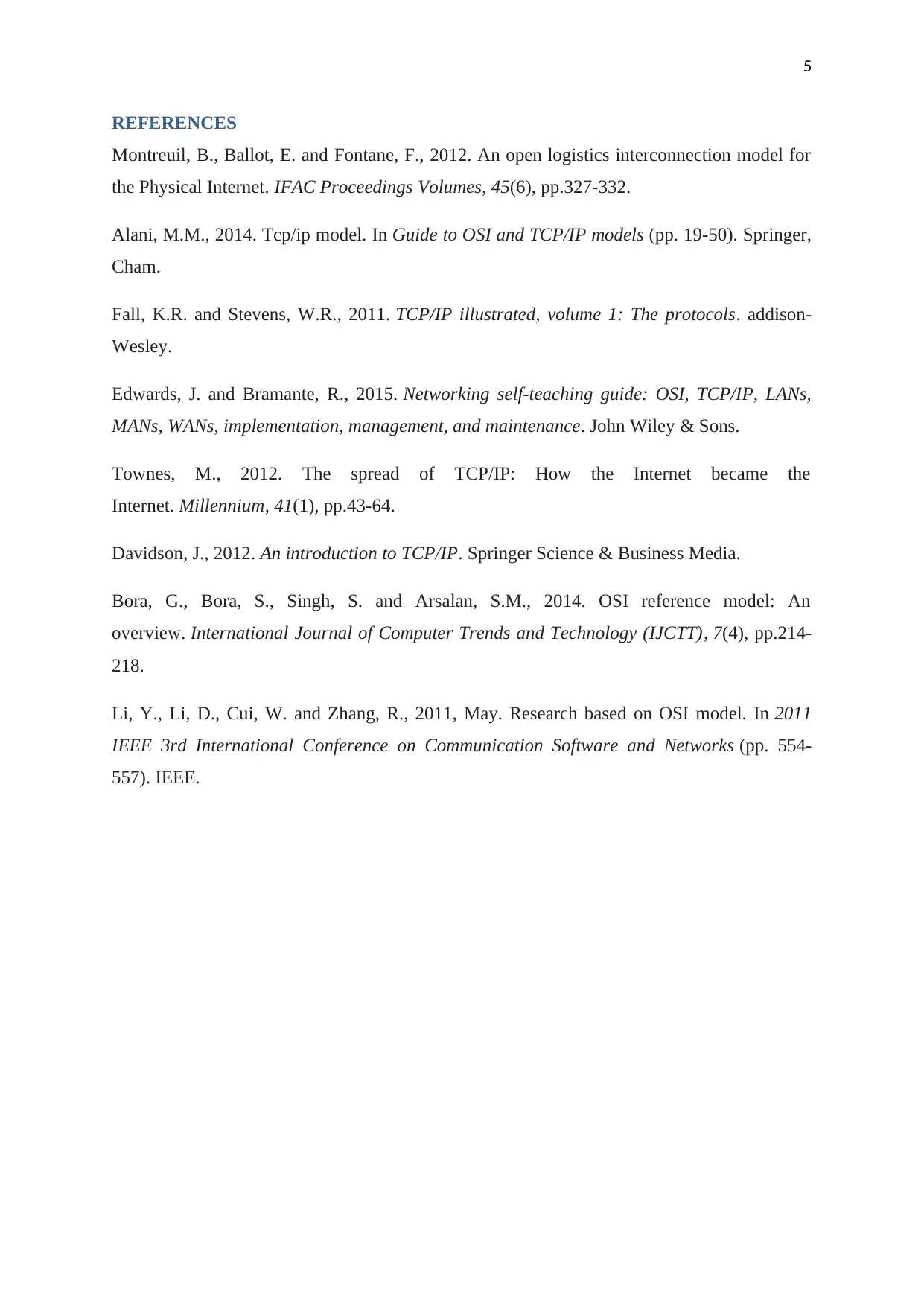
5
REFERENCES
Montreuil, B., Ballot, E. and Fontane, F., 2012. An open logistics interconnection model for
the Physical Internet. IFAC Proceedings Volumes, 45(6), pp.327-332.
Alani, M.M., 2014. Tcp/ip model. In Guide to OSI and TCP/IP models (pp. 19-50). Springer,
Cham.
Fall, K.R. and Stevens, W.R., 2011. TCP/IP illustrated, volume 1: The protocols. addison-
Wesley.
Edwards, J. and Bramante, R., 2015. Networking self-teaching guide: OSI, TCP/IP, LANs,
MANs, WANs, implementation, management, and maintenance. John Wiley & Sons.
Townes, M., 2012. The spread of TCP/IP: How the Internet became the
Internet. Millennium, 41(1), pp.43-64.
Davidson, J., 2012. An introduction to TCP/IP. Springer Science & Business Media.
Bora, G., Bora, S., Singh, S. and Arsalan, S.M., 2014. OSI reference model: An
overview. International Journal of Computer Trends and Technology (IJCTT), 7(4), pp.214-
218.
Li, Y., Li, D., Cui, W. and Zhang, R., 2011, May. Research based on OSI model. In 2011
IEEE 3rd International Conference on Communication Software and Networks (pp. 554-
557). IEEE.
REFERENCES
Montreuil, B., Ballot, E. and Fontane, F., 2012. An open logistics interconnection model for
the Physical Internet. IFAC Proceedings Volumes, 45(6), pp.327-332.
Alani, M.M., 2014. Tcp/ip model. In Guide to OSI and TCP/IP models (pp. 19-50). Springer,
Cham.
Fall, K.R. and Stevens, W.R., 2011. TCP/IP illustrated, volume 1: The protocols. addison-
Wesley.
Edwards, J. and Bramante, R., 2015. Networking self-teaching guide: OSI, TCP/IP, LANs,
MANs, WANs, implementation, management, and maintenance. John Wiley & Sons.
Townes, M., 2012. The spread of TCP/IP: How the Internet became the
Internet. Millennium, 41(1), pp.43-64.
Davidson, J., 2012. An introduction to TCP/IP. Springer Science & Business Media.
Bora, G., Bora, S., Singh, S. and Arsalan, S.M., 2014. OSI reference model: An
overview. International Journal of Computer Trends and Technology (IJCTT), 7(4), pp.214-
218.
Li, Y., Li, D., Cui, W. and Zhang, R., 2011, May. Research based on OSI model. In 2011
IEEE 3rd International Conference on Communication Software and Networks (pp. 554-
557). IEEE.
⊘ This is a preview!⊘
Do you want full access?
Subscribe today to unlock all pages.

Trusted by 1+ million students worldwide
1 out of 6
Related Documents
Your All-in-One AI-Powered Toolkit for Academic Success.
+13062052269
info@desklib.com
Available 24*7 on WhatsApp / Email
![[object Object]](/_next/static/media/star-bottom.7253800d.svg)
Unlock your academic potential
Copyright © 2020–2025 A2Z Services. All Rights Reserved. Developed and managed by ZUCOL.




